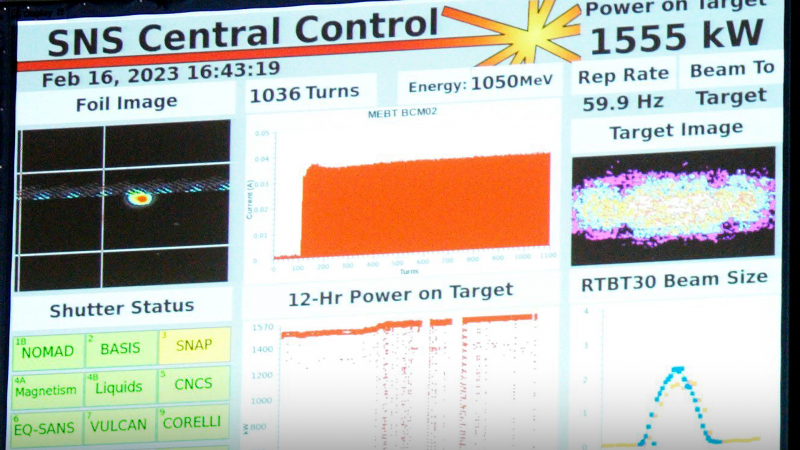The Spallation Neutron Source at the Department of Energy's Oak Ridge National Laboratory set a world record when its linear accelerator reached an operating power of 1.55 megawatts, which improves on the facility’s original design capability.
The accelerator’s higher power provides more neutrons for researchers who use the facility to study and improve a wide range of materials for more efficient solar panels, longer lasting batteries and stronger, lighter materials for transportation. The achievement marks a new operational milestone for neutron scattering in the United States and opens the door to tackling more difficult questions and problems in materials science research.
“Reaching 1.55 megawatts at the Spallation Neutron Source is an exciting step toward completing the Proton Power Upgrade project, and it has been made possible because of the outstanding dedication and commitment of every member of the Neutron Sciences team at Oak Ridge National Laboratory,” said interim ORNL Director Jeff Smith. “It is an incredible privilege to work at ORNL and be part of the neutron science community. There are many cheering on our work around the world as we enable SNS to break new ground across science.”
ORNL is celebrating its 80th anniversary this year and continues to build upon the pioneering neutron legacy of the laboratory’s decommissioned Graphite Reactor, a historical landmark and site of some of the world’s first neutron scattering experiments, conducted by Clifford Shull and Ernest Wollan.
“Those Nobel Prize-winning achievements have been a guiding light for this institution for decades, and I believe the work taking place today at SNS will have a similar impact on future generations of scientists at ORNL,” said Smith.
Since construction was completed in 2006, the SNS has been a world-leading DOE Office of Science user facility that provides powerful advanced scientific capabilities for thousands of researchers from around the world to study energy phenomena and materials from the atomic scale to mesoscales.
The facility produces neutrons by accelerating protons down a 300-meter-long linear accelerator and into a liquid mercury target. Upon impact, a “spall” of neutrons is routed to surrounding high-powered research instruments, which enables scientists to guide the neutrons used to study the atomic structure and behavior of various materials. Neutrons scatter off atoms within the material and are captured by high-speed detectors, revealing fundamental information for research teams to analyze.
A megawatt is a unit of measure of the beam power of a particle accelerator. The SNS’ 1.55-megawatt power level was reached after the recent installation of additional accelerating systems, part of the ongoing Proton Power Upgrade project at the accelerator.
ORNL’s Proton Power Upgrade will continue to push the linear accelerator’s power capability up to 2.8 megawatts. This will increase the number of neutrons available for experiments at the existing First Target Station to enable new discoveries and power the planned Second Target Station, a complementary third neutron source at ORNL. STS will address emerging science challenges through experiments not currently feasible nor routine, with the ability to study smaller or less concentrated samples or those under more extreme environmental conditions.
Besides SNS, ORNL is home to the High Flux Isotope Reactor. Completed in 1965 and operating at 85 megawatts, HFIR’s steady-state neutron beam is the strongest reactor-based neutron source in the United States.
The SNS and HFIR facilities produce neutron beams that help spur innovations that lead to improvements in our daily lives, such as more powerful computers, cleaner air, more effective drugs and longer-lasting batteries.
The SNS and HFIR are DOE Office of Science user facilities. UT-Battelle manages ORNL for the Department of Energy’s Office of Science, the single largest supporter of basic research in the physical sciences in the United States. The Office of Science is working to address some of the most pressing challenges of our time. For more information, please visit energy.gov/science. — by Paul Boisvert






